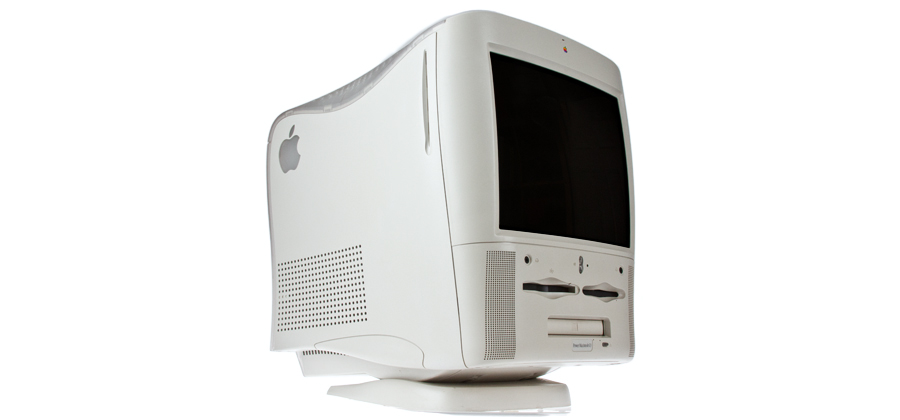The rise and fall of Apple's all-in-one machines<div class="field field-name-body field-type-text-with-summary field-label-hidden"><div class="field-items"><div class="field-item even" property="content:encoded"><p class="intro">As long as the Macintosh has been around, there have been all-in-one models.</p> <p>All-in-ones (or AIOs) are desktop computers where all the major components—logic board, storage, display and more—are in the same case. These designs are much neater and cleaner than your traditional PC setup, which requires a separate computer, screen, and lots of cables running everywhere.</p> <p>For the last 17 years, Apple's AIO offering has been the iMac. While the 27-inch iMac with Retina 5K display is a far cry from the 9-inch black-and-white CRT Macintosh Steve Jobs unveiled way back in 1984, they share DNA and a common design philosophy: Simplicity is king.</p> <h2>In the beginning</h2> <p>The original Macintosh 128k wasn't a huge success, in part to the computer industry's response to the machine. While the simplicity and elegance is still obvious today, some looked at the computer as a toy—ill-equipped for real work.</p> <p><a href='
http://www.imore.com/rise-and-fall-apples-all-one-machines' title="The rise and fall of Apple's all-in-one machines"><img src='
http://www.imore.com/sites/imore.com/files/styles/large/public/field/image/2015/08/Macintosh-128k_0.jpeg?itok=0CXduoij' />[/url]</p> <p>
Image Credit: iFixit</p> <p>Part of this was due to the case and physical design of the machine. It was small and approachable, but because Apple kept users from being able to open the case and tinker—a standard at the time—many wrote it off before ever learning about its industry-changing software.</p> <p>But Apple pressed on, rapidly innovating on the original design. The majority of early Macs were of the same "compact" design as the original—an all-in-one case built around a 9-inch black and white CRT—but the company iterated by adding internal hard drives, better disk drives and more RAM. The chassis was finally retired when the Color Classic II (also named the Performa 275) was pulled from shelves with little fanfare in May of 1994.</p> <h2>Losing the all-in-one way</h2> <p>By 1994, Apple was a mess. The company had multiple competing Macintosh product lines, few of which were successful.</p> <p>One such line was the
Perfoma: The computers were made up largely of recycled Mac internals from other lines, hidden within a case sporting a built-in 14-inch color CRT. They were often found in schools and homes, while the Quadras and Power Mac lines were sold to the higher end of the market.</p> <p>These mid-90s all-in-one Macs are mostly all forgettable: Many of them were re-badged and named over the years, contributing to some of the most confusing product names I've ever come across.</p> <p>There is one exceptional machine in the bunch:
the Mac TV, which shipped with a black case and built-in TV tuner card. Past that, the all-in-one scene in the 1990s was a sea of endless, mind-numbing beige.</p> <h2>The turning point</h2> <p>When I was in high school, I worked at the student newspaper, laying out pages on a 1998
Power Macintosh G3 All-in-One.</p> <p><a href='
http://www.imore.com/rise-and-fall-apples-all-one-machines' title="The rise and fall of Apple's all-in-one machines"><img src='

?itok=xaa2DRqq' />[/url]</p> <p>
Image Credit: Jonathan Zufi, iconicbook.com</p> <p>I'm of the mindset that this machine—dubbed the "Molar Mac" for
its tooth-like appearance—is historically important, as it helped reintroduce the Mac community to AIOs that mattered. It's also the closest in design to Apple's perhaps most significant AIO of the 1990s: The original iMac, with its translucent plastic and swooping curves. The Molar Mac has largely been forgotten, set out to pasture with a bunch of other old Macs that no one really remembers. But it paved the way for something great.</p> <h2>The peak</h2> <p>In early 1998, Steve Jobs took the stage to introduce the original iMac. Clad in "bondi blue" translucent plastic, the design was a true return to the all-in-one design.</p> <p><a href='
http://www.imore.com/rise-and-fall-apples-all-one-machines' title="The rise and fall of Apple's all-in-one machines"><img src='
http://www.imore.com/sites/imore.com/files/styles/large/public/field/image/2015/08/bondi-blue-imac_0.jpeg?itok=uczgONul' />[/url]</p> <p>Gone were the expansion cards found in the Molar Mac. This iMac—with the exception of a small door allowing the user to add more RAM—was a sealed system. And, like the Macintosh 128k, it was approachable and friendly. It brought magic back to the Macintosh, and set the stage for Apple's return to profitability.</p> <p>The 2000s are chock-full of some
great iMacs. The original G3 line
grew and expanded at an astonishing rate, only to be followed by the
iMac "Sunflower" G4, the
iMac G5 and, of course, an entire line of Intel-powered machines that range from the original 17-inch Core Duo machine in 2006 to today's Retina-infused 27-inch monster.</p> <h2>Looking toward the future</h2> <p>As great as the current iMacs are, I can't help but think the best days of the all-in-one design are behind it. I think there will always be room for the iMac in Apple's lineup, but it's clearly not where the company is making most of its money. That hasn't been true for a long time: Apple now sells
way more notebooks than desktops, and that trend isn't going to reverse anytime soon. While the Retina iMac is a huge step forward, notebooks and iOS devices are where Apple is currently doing its strongest hardware work. (Of course, given that both are closed AIO systems, you could say that Apple's taken a bit of its history forward even as the iMac line starts to fade.)</p> <p>No matter what comes in the years ahead for computers, iOS devices, or cars, the iMac will always have a special place in the company's—and many users's—hearts. I know it does in mine.</p> </div></div></div><br clear='all'/>
<a href="
http://rc.feedsportal.com/r/234567782505/u/49/f/616881/c/33998/s/494fa615/sc/28/rc/1/rc.htm" rel="nofollow"><img src="
http://rc.feedsportal.com/r/234567782505/u/49/f/616881/c/33998/s/494fa615/sc/28/rc/1/rc.img" border="0"/>[/url]
<a href="
http://rc.feedsportal.com/r/234567782505/u/49/f/616881/c/33998/s/494fa615/sc/28/rc/2/rc.htm" rel="nofollow"><img src="
http://rc.feedsportal.com/r/234567782505/u/49/f/616881/c/33998/s/494fa615/sc/28/rc/2/rc.img" border="0"/>[/url]
<a href="
http://rc.feedsportal.com/r/234567782505/u/49/f/616881/c/33998/s/494fa615/sc/28/rc/3/rc.htm" rel="nofollow"><img src="
http://rc.feedsportal.com/r/234567782505/u/49/f/616881/c/33998/s/494fa615/sc/28/rc/3/rc.img" border="0"/>[/url]
<img src="[url]http://da.feedsportal.com/r/234567782505/u/49/f/616881/c/33998/s/494fa615/sc/28/a2.img" border="0"/>[/url]<img width="1" height="1" src="
http://pi.feedsportal.com/r/234567782505/u/49/f/616881/c/33998/s/494fa615/sc/28/a2t.img" border="0"/><img width='1' height='1' src='

' border='0'/><img src="
http://feeds.feedburner.com/~r/TheIphoneBlog/~4/_vKnwa079-c" height="1" width="1" alt=""/>
Source:
The rise and fall of Apple's all-in-one machines